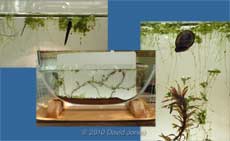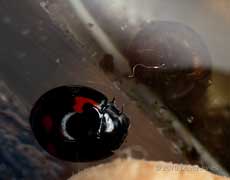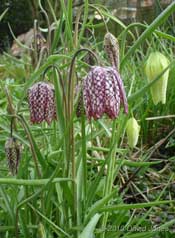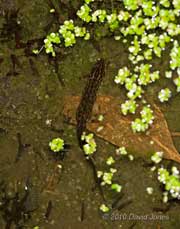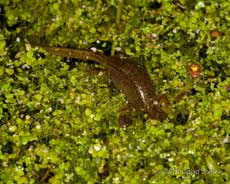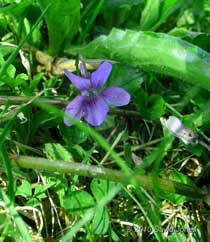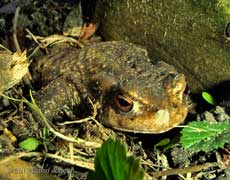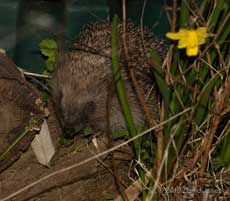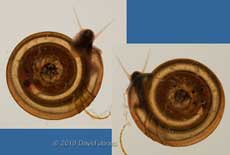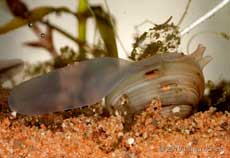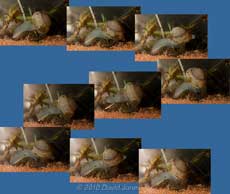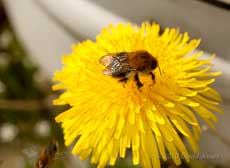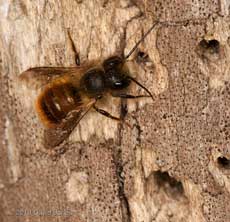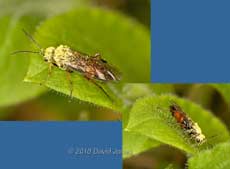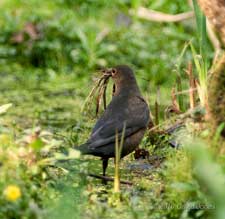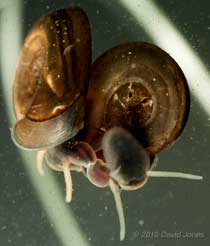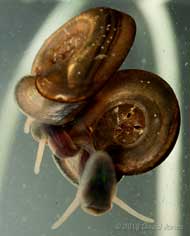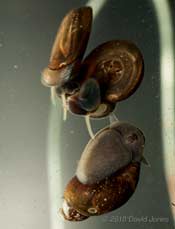Go to the last entry on this page .....Go to previous entry4 April - Apart from the nesting birds and the occasional bumblebee, the garden has been rather quiet this last week, despite the weather not being as bad as was forecast. There has been no new flowering to report on, and while the Snake's Head Fritillaries in the local garden centre have been in bloom for the last week or so, those by our big pond probably have another couple of days to go. Today I sorted out my mini-aquarium ready for my little grand-daughter's next visit. It now contains a few tadpoles, some snails, flatworms, freshwater shrimps and a cockle for her to look at. The tank is normally used for photography. It measures about 45cm wide at the top, and is about 16cm tall, but the water column is only 2cm thick.
In the big pond some of the tadpoles are now just about free swimming, although the majority are still clustered around the algae covered remnants of the frog spawn. Usually at this stage a night time inspection reveals newts that are taking advantage of an easy feast before their mating season starts, but so far I have not seen a single newt in the pond - no doubt another effect of the cold winter.
One unexpected sighting as I set up the aquarium was this Pine Ladybird which actually appeared on the glass while I was pond-dipping. It is only the second ladybird I've seen so far this year, and measuring no more than 4mm in length it is one of our smaller ladybirds.
5 April - A bright and mainly sunny day, but I only spent a short time in the garden. The highlight of the day was the squeal of delight given by my grand-daughter (who is two and enjoys swimming) when a tadpole swam nearly a length of the tank!
In the garden, my estimate for the Snake's-head Fritillary flowering proved wrong when today's sunshine performed its magic on a few of the flower buds.
8 April - An early taste of summer today. While the temperature only reached 15C, it felt much warmer in the sunshine.
and last night I spotted this one hunting on the big pond's duckweed canopy.
Today's sunshine has brought another one of our regulars into flower, the Violets.
However, the highlight of the day has to be this Toad. The last time I saw a toad in the garden was in November 2006, and I last heard one (but could not find it) here in August 2007.
And to finish off a bright day, tonight at 9pm the garden is being visited by the first hedgehog that I've seen here since March last year. While it is easy to miss visits by a normally nocturnal visitor, I can usually find the signs (droppings) that hedgehogs leave behind, especially on our veranda, but there have been none since last Spring.
And I nearly forgot - there was a Brimstone butterfly in the garden briefly this morning. A good day!
9 April - Another summery day, and for the first time this year we sat out in the garden for our morning coffee break! First, two things to note about yesterday. As if to reinforce what I said about the hedgehog, this morning there were the tell-tale droppings on our veranda! Also, I forgot to mention that yesterday morning I saw my first Harlequin ladybird of the year, not actually in our garden but on a vehicle parked on the road outside our house. Today's couple of pictures are from the mini-aquarium and are of two very different molluscs.
The first is this small freshwater snail which measures about 5mm across the widest part. It a member of the Planorbis genus, and may be P. contortus.
The shell of this individual measures about 9mm across. It is a filter feeder, taking in water through one siphon and expelling it via the other one. I have yet to sort out which is which! One advantage of having it in the tank is that you get a chance to see something of its behaviour. Sometimes it is partly buried in the sand, but it is quite capable of moving about, albeit rather slowly. This next set of pictures illustrates that movement through what I could best describe as two cockle paces!
Then, in a quick movement, the shell is twisted so that the siphons are raised, the shell is pulled forward, before the shell is twisted back in the opposite direction so that the siphons come in contact with the substrate (sand) once again. The sequence is then repeated as the cockle moves forward. Certainly not the smooth glide of the snails!
10 April - The taste of Summer continues, and it tempted me into shorts and sandals today as we sorted out the veranda after its neglect during the winter months - it was a day for both our coffee break and main meal outside. It was also quite an interesting day in terms of the garden. We saw three species of butterfly, another Brimstone, a Peacock, and a small brown one which we didn't get the chance to idenitfy. I also spotted but failed to photograph our first hoverfly of the year, as well with a Bee-fly, and an all-black bumble bee which I have yet to succeed in photographing. These seem very sensitive to movements anywhere near to them.
However, I did manage a picture of this unidentified bumble bee on a dandelion near to one of the bee hotels. Look to the lower left of the picture and you will see the blurred shape of the first solitary bee to take an interest in (or had recently emerged from) the hotel. It was about to mob the bumblebee. Could it have mistaken the bumbebee for a prospective mate, or did it regard its presence as a threat?
It took a while before the solitary bee settled long enough for me to take a photograph of it. I think that it is Osmia rufa. The white tuft on its face, along with its behaviour indicate that it is a male.
Another insect I'll need to identify, although I suspect that it is a sawfly. Obviously, this one had just visited a flower.
The Blackbird is nest building again. Through much of the day she visited the big pond to collect soggy building materials for the nest. What a contrast to the dry hair and wool being taken in by the Great Tit at the moment. I couldn't make out where she was flying off to, although I suspect it is the conifers beyond the bottom of the garden.
The mini-aquarium has occupied a few more minutes of my time again today, with two similar events taking place during the afternoon. First, I spotted that two of the larger (over 10mm across) Ramshorn snails were mating. While one snail remained secured to an Elodia leaf, the second snail was perched on its partner's shell and had its penis extended into the opening of that 'partner'. It's a long time since I last read about snail reproduction, so I shall have to investigate this behaviour in a bit more depth. While at the moment I believe that these snails are hermaphrodite, during this encounter I only saw one extend its penis.
In contrast, when this pair of a smaller species (each measuring 5mm across) started mating, there was no doubt about their hermaphroditic nature, with both penises visible in the picture.
However, while it was difficult to be sure, I could see only one penis actually inserted into the partner's shell opening (operculum) at a time,
and at one stage their encounter was almost interrupted completely by the arrival of a third snail of a very different species, although this intruder was more interested in grazing on the film of algae that is building up on the aquarium glass. I hope to watch more of this reproductive behaviour in order to record more details of the process in the different pond snails. It would be good to be there to see the mating start.
I wonder if there is any chance of photographing reproduction behaviour between freshwater cockles? I shall have to collect some mature specimens form the pond.
Click on images to see larger version |
|
